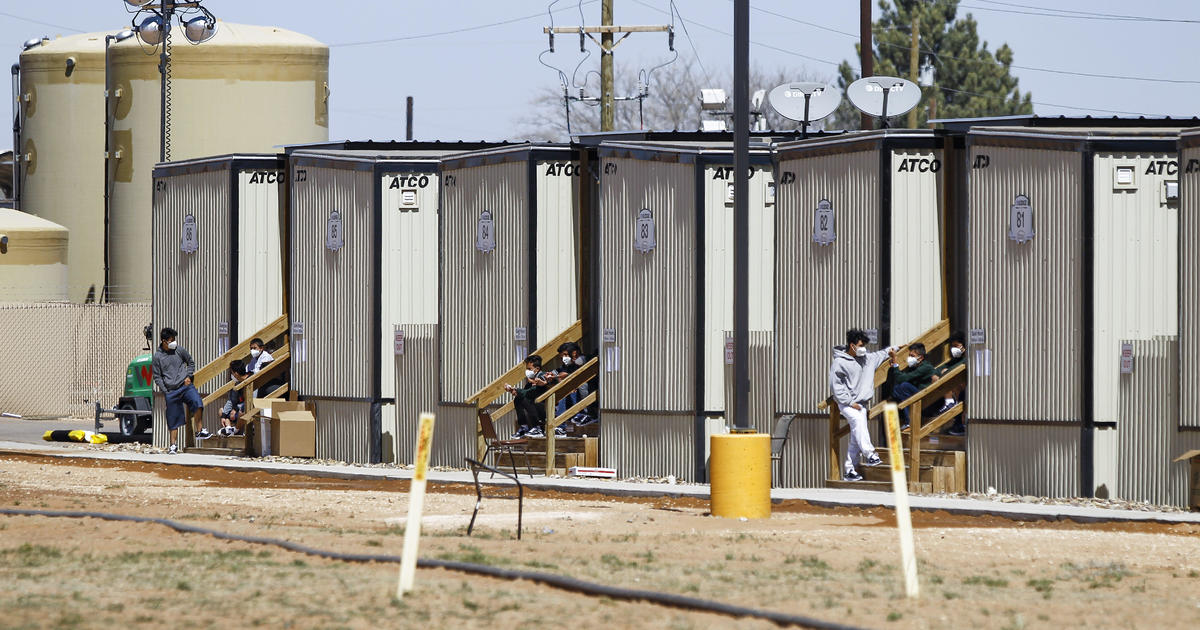
The U.S. government housed about 15,500 unaccompanied migrant minors on Saturday, including 5,000 teenagers and children stranded in border surveillance facilities not designed for long-term detention, according to government data reviewed by CBS News.
As of Saturday morning, more than 5,000 unaccompanied minors were held in a Customs and Border Protection (CBP) tent holder in South Texas and other stations along the border with Mexico. According to government records, unaccompanied children spend an average of 136 hours in CBP custody, well above the 72-hour limit set by US law.
The Department of Health and Human Services (HHS) also housed nearly 10,500 unaccompanied children in emergency housing facilities and shelters licensed by states to care for minors, department spokesman Mark Weber told CBS News Saturday.
More than 9,400 unaccompanied minors entered U.S. border detention last month, a record high for February. That number is expect to be overshadowed According to the March figure, border officials have encountered an average of more than 500 unaccompanied minors per day in the past 21 days, according to government data.
The refugee agency within HHS is in charge of housing most unaccompanied minors until it can place them with relatives or other sponsors in the US. Due to the large number of unaccompanied children crossing the southern border and limited sleeping space in state-approved shelters, the U.S. refugee agency has been forced to open makeshift housing facilities to release children from Border Patrol custody.
Eli Hartman / AP
On Saturday, HHS informed Congress that it would open a new inflow facility in Pecos, Texas, which is initially expected to house about 500 unaccompanied children, according to a report obtained by CBS News. HHS said the facility, a former housing facility for oil workers, could be expanded to 2,000 minors in the future.
The Pecos facility would become the fourth inflow or emergency housing facility for unaccompanied minors to be opened by the Biden administration, which is seeking bed space for the vast number of children arriving at the U.S.-Mexico border without parents or legal guardians. The Trump administration used three inflow facilities for migrant children over the age of four.
Last month, the U.S. Refugee Agency reopened a Trump-era inflow facility in Carrizo Springs, Texas. With the help of the Federal Emergency Management Agency, the refugee office has also converted a conference center in Dallas and an oil workers’ camp in Midland, Texas, into emergency locations to accommodate unaccompanied teens trapped in Border Patrol facilities, most of which are built to hold migrant men.
Figures reviewed by CBS News on Saturday show the U.S. government continues to struggle to reduce the record-breaking backlog of children in U.S. border detention, even as it opens new housing facilities and expands bed capacity in state-approved shelters.
“The staggering number of children in CBP custody is both heartbreaking and deeply concerning,” Neha Desai, a lawyer representing migrant minors in a landmark lawsuit, told CBS News.
Last week, Desai and her colleague from the National Center for Youth Law, Leecia Welch, interviewed migrant minors held in the Border Patrol tent in Donna, Texas. According to Desai, the children reported taking turns sleeping on the floor crowded conditionsCannot call family members; and shower once every seven days.
Desai said she believes that “the Biden government is committed to a humane approach to the humanitarian situation we face today,” but that “time will tell if the government’s good intentions and hard work will translate into the changes that are urgently needed. “
On Friday, Paul Wise, a court-appointed physician charged with monitoring the conditions facing migrant children in US custody, told U.S. District Court Judge Dolly Gee that he found “profound overcrowding” in the Donna. holding and other CBP stations in South Texas that it toured last week.
Wise warned that the overcrowded conditions were not “sustainable,” and said storage capacity along the southern border could begin to unravel.
CBP told CBS News in a statement that it is working to transfer unaccompanied minors to HHS shelters “as soon as we can.” Echoing statements by Secretary of Homeland Security Alejandro Mayorkas, the agency said the Border Patrol facilities “are not intended to hold children long term.”
“Even a few hours in custody is more than we want for children Border Patrol arrests at the border,” the agency said in a statement.
Since the Centers for Disease Control and Prevention (CDC) allowed shelters in early March to ease social remoteness and return to pre-pandemic capacity, the U.S. refugee office has reactivated more than 500 beds, an agency spokesman said earlier this week. CBS News.
Although the refugee agency is no longer considering using a Virginia military base or a NASA facility in Northern California to house unaccompanied children, it is still evaluating other sites, according to Weber, the HHS spokesperson.
Citing a public health authority dating back to the late 1800s, the Trump administration promptly expelled thousands of unaccompanied children from the southern border without allowing them to seek asylum until a federal judge resolves the practice blocked in November 2020.
While an appeals court lifted the judge’s order in late January, Biden’s government refused to deport unaccompanied migrant children, calling the practice inhumane. The Biden administration has continued to use the Trump-era public health ordinance to deport adult migrants and some families with children.
“We made a different decision than the previous government,” Mayorkas said on “CBS This Morning” on Thursday. “We do not return young children to the environment of poverty and violence from which they flee.”
